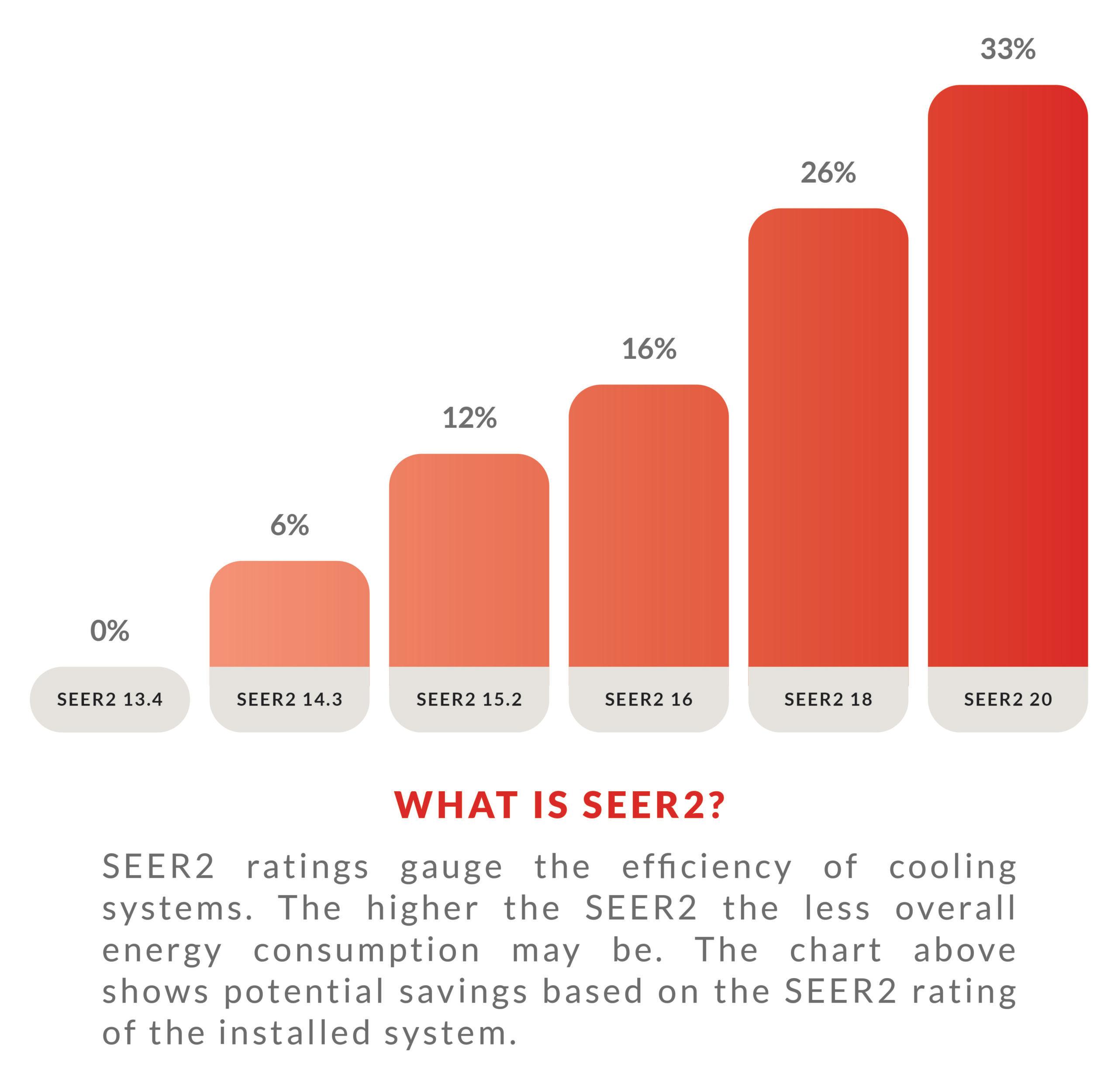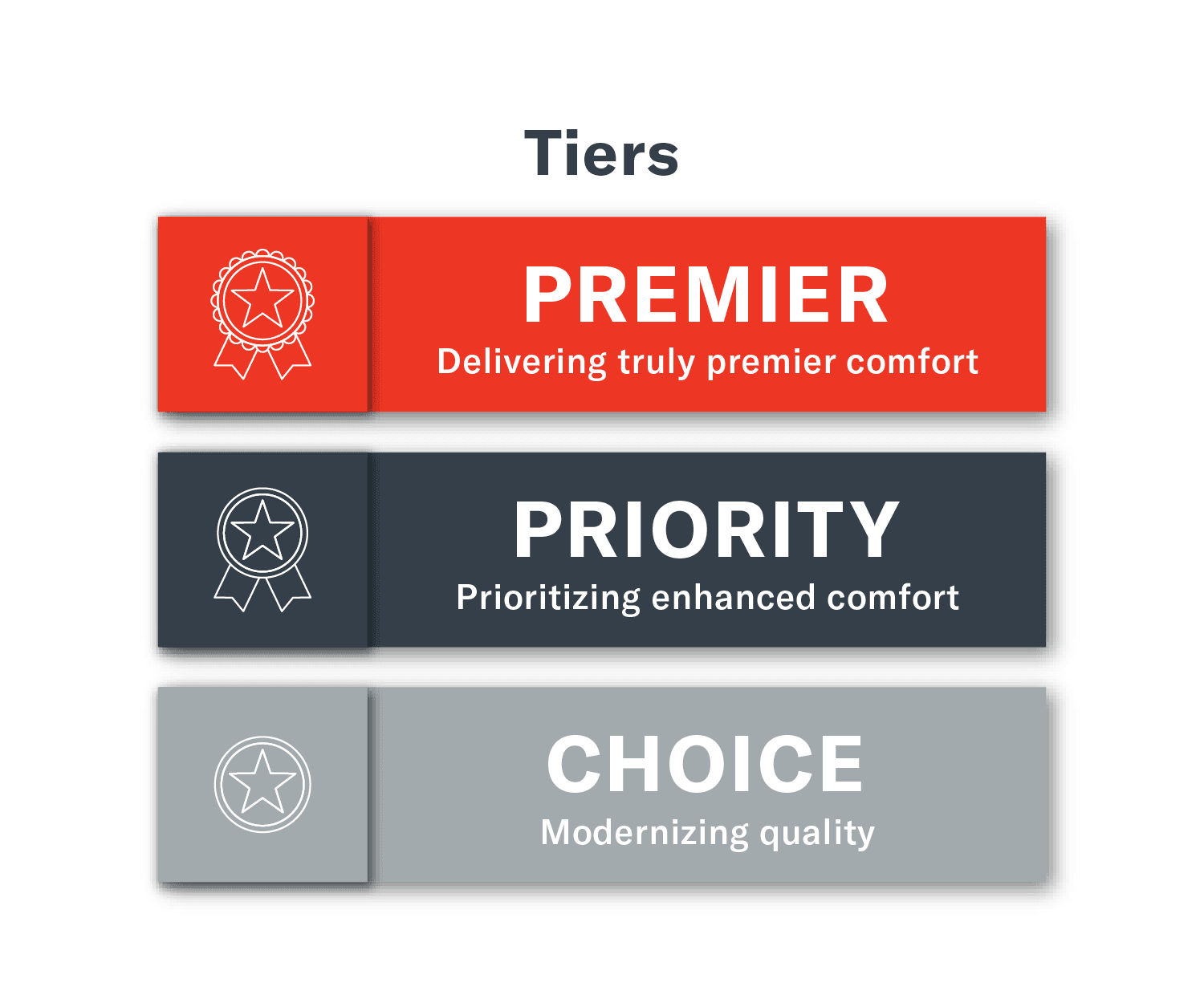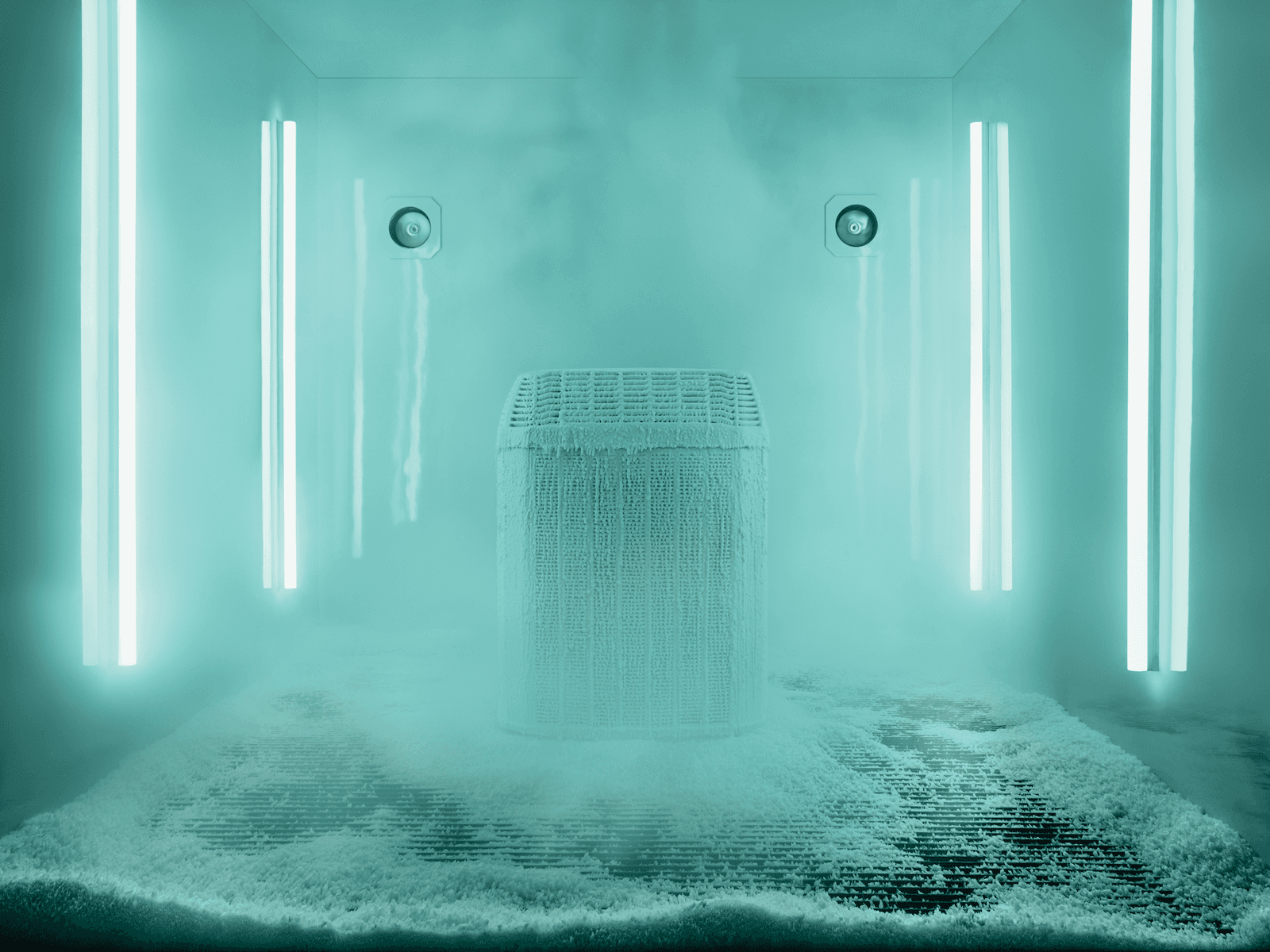What’s a Good SEER2 Rating?
Discover how an air source heat pump or air conditioner’s SEER2 efficiency rating can affect your comfort and energy bills.
By Anne Fonda
It’s tough to give a quick answer here because a good SEER2 rating depends on what you want in a cooling system. We can tell you that energy-efficient AC systems and electric heat pump systems can lead to energy savings and lower utility bills.
What does SEER mean in HVAC? A SEER definition
First, the basics. Just what is SEER? SEER stands for Seasonal Energy Efficiency Ratio. You may see it referred to as a SEER rating. This is the ratio of the cooling output of an air conditioner or heat pump over a typical cooling season, divided by the energy it uses in Watt-Hours.
Understanding SEER meaning
Is a high SEER rating good? Yes. The higher the SEER, the more efficient a unit is at cooling your home. A heat pump or central air conditioner’s SEER energy efficiency rating is calculated over an entire cooling season using a constant indoor temperature and a variety of outdoor temperatures ranging from 65°F to 104°F. This is how it simulates a typical season.
SEER2 is the AVERAGE efficiency across a wide range of conditions. So, it is like the ‘combined’ fuel efficiency of your car. You may get higher efficiency on the highway or lower efficiency in the city, but the average ‘combined’ efficiency you will see is like the SEER2 rating.
The same goes for your air conditioner or heat pump. If your SEER is 20, that’s the efficiency rating, and it could be higher or lower depending on conditions. On Trane product descriptions, you may see “up to” when talking about the unit’s SEER rating.
That means with the right matching equipment and optimal conditions, you may be able to increase efficiency beyond what the unit is rated for.
SEER2 vs SEER definition
Effective January 1, 2023, the Department of Energy (DOE) mandated updated HVAC energy efficiency standards. SEER2 is an updated version of the SEER calculation that uses the new M1 blower testing procedure. So, if you've shopped for a new unit in the past, you may recognize that SEER has changed to SEER2, as SEER2 represents the new standard.
SEER2, or Seasonal Energy Efficiency Ratio 2, includes the total heat removed from the conditioned space during the annual cooling season, and the new M1 testing procedure increases the systems’ external static pressure by a factor of five to better reflect real-world conditions of installed equipment.

*Based on national averages
SEER2 vs EER2
EER2 stands for Energy Efficiency Ratio. It’s another HVAC efficiency metric that measures a unit’s cooling efficiency.
The difference between SEER2 and EER2
The two metrics use different temperature conditions.
- EER2 measures efficiency at the peak cooling need when the outdoor temperature is 95°F, the indoor temperature is 80°F, and the humidity is 50%.
- SEER2 is an average efficiency rating over the entire cooling season when temperatures range from 65°F to 104°F.
A unit’s EER2 rating may be more important than the SEER2 rating if your summers are long and hot. Work with an experienced HVAC professional to determine your needs.
Benefits of a high SEER2 rating
There are 3 main benefits to a higher SEER2 rating.
Higher energy efficiency
The higher the SEER2 rating, the more efficient the unit is. That means a higher efficiency unit will use less energy to reach and maintain your desired temperature and decrease humidity.
Lower energy bills
Higher efficiency = cost savings on your monthly cooling bills. Read some of the reviews of our most energy-efficient units for real-life examples of how much homeowners saved on energy costs after installing a new Trane system.
Greater indoor comfort
Variable speed systems offer precise temperature control and enhanced humidity control to keep you comfortable no matter how hot and humid it is outside.
What AC or heat pump SEER2 rating is right for you?
That’s a personal decision, and we don’t have the answer. However, if you consult with your local Trane dealer, they can go over the pros and cons of the various units and their SEER2 ratings to help you find the energy-efficient AC unit or energy-efficient heat pump that best meets your needs and your budget.
You should know that a high-efficiency variable-speed unit will come with a higher price tag than a single-stage unit with a lower SEER2 rating. But that less efficient unit will cost more to run for the next 15 years or so, while the high-efficiency unit should result in energy savings for the same period, which can more than make up for the additional upfront cost.
However, if you have short, mild summers or don’t plan to live in your home long, a single-stage unit might be the right choice.

The table below compares our Premier, Priority, and Choice product lines. Visit specific air conditioner and heat pump product pages for full details.
| Premium | Priority | Choice | |
| Compressor Performance | Variable-speed Climatuff® compressor | Multi-speed Climatuff® compressor | Single-stage Climatuff® compressor |
| Efficiency | 17 SEER2 up to 23.6 SEER2 and up to EER2 of 14, all units are ENERGY STAR®-qualified | Up to 18 SEER2 and EER2 up to 13, all units are ENERGY STAR®-qualified | 13 SEER2 up to 17 SEER2, only specific units are ENERGY STAR®-qualified |
| Diagnostic Technology | Trane Diagnostics | Trane Diagnostics with a compatible smart thermostat | Trane Diagnostics with a compatible smart thermostat |
| Durability | -WeatherGuard™ included or available as an accessory -Galvanized steel panels -Powder paint finish to prevent corrosion and rust -All-aluminum SpineFin™ coil | -WeatherGuard™ included or available as an accessory -Galvanized steel panels, powder paint finish to prevent corrosion and rust -All-aluminum SpineFin™ coil | -WeatherGuard™ included or available as an accessory -Galvanized steel panelsPowder paint finish to prevent corrosion and rust -All-aluminum SpineFin™ coil |
| Sound Level | Compressor sound enclosure for 64-76 dB(A) | 72-74 dB(A) | 71-73 dB(A) |
| Best Thermostat | Trane LINK UX360 Smart Thermostat | XL824 Smart Thermostat | XL824 Smart Thermostat |
| Limited Warranty | 12-year limited warranty compressor, 10-year limited warranty on outdoor coil and functional parts with registration | 10-12-year limited warranty compressor depending on the unit, 10-year limited warranty on outdoor coil and functional parts with registration | 10-12-year limited warranty compressor depending on the unit, 10-year limited warranty on outdoor coil and functional parts with registration |
-Galvanized steel panels
-Powder paint finish to prevent corrosion and rust
-All-aluminum SpineFin™ coil
-Galvanized steel panels, powder paint finish to prevent corrosion and rust
-All-aluminum SpineFin™ coil
-Galvanized steel panelsPowder paint finish to prevent corrosion and rust
-All-aluminum SpineFin™ coil
SEER2 14 vs SEER2 18
An 18 SEER AC unit or 18 SEER heat pump is about 20% more energy efficient than a 14 SEER2 unit. This is because of the lower SEER2 on the 14 SEER2 units, but also because they are single-stage units.
Single-stage air conditioners and heat pumps are either on at 100% or they’re off. The frequent starting and stopping needed to try and maintain the temperature in the summer means they use more energy.
14 SEER2 vs 20 SEER2
A 20 SEER2 heat pump or AC unit is about 43% more efficient than a 14 SEER2 unit. A Trane 20 SEER2 unit can operate anywhere from 30-100% capacity.
This variable speed capability allows the unit to run for longer periods at lower speeds to offer precise temperature and humidity control. Running at a lower speed is more efficient than turning off and starting up again. That higher efficiency can save you some serious money if you run your AC 3-6 months out of the year.
Is a higher SEER2 rating worth paying more for?
That’s a question only you can answer.
Higher SEER variable speed or multi-speed units have a higher upfront cost but will cost less to operate while providing better temperature and humidity control than a single-stage 14 SEER2 unit. Our 20 SEER2 units are highly efficient variable speed systems.
They use the minimum energy to provide optimal comfort. By operating at lower speeds, they can help lower your energy consumption, leading to long-term energy savings and cost savings. Most higher-efficiency units qualify for federal tax credits and/or rebates.
What SEER2 rating qualifies for the HVAC tax credit?
To qualify for the heat pump tax credit and heat pump rebates under the Inflation Reduction Act of 2022, a split ducted heat pump must have a SEER2 rating of at least 16. A packaged heat pump must have a SEER2 of at least 15.2 to qualify. Heat pumps must also meet HSPF2 and EER2 minimum efficiency ratings to qualify.
Split system air conditioners can qualify for the federal energy tax credit (25C credit) if they have a SEER2 of 17 or higher and an EER2 of 12 or higher, while gas/electric packaged systems must have a SEER2 of 15.2 or higher.
Learn more about how you can stack HVAC tax credits and rebates to save on an energy-efficient HVAC system.
What is Trane’s most energy-efficient heat pump?
For split system heat pumps, the highest SEER2 heat pump is the 20 TruComfort™ Variable Speed Heat Pump with WeatherGuard™. Rated as a 20 SEER2 heat pump, this unit can heat and cool your home efficiently. It has an actual SEER2 of up to 22.4 and an HSPF2 of up to 10.5.
What is Trane’s most energy-efficient air conditioner?
The 20 TruComfort™ Variable Speed Air Conditioner with WeatherGuard™ is our most energy-efficient AC unit. Rated as a 20 SEER2 AC unit, it can reach a SEER2 up to 23.6 when paired with the right indoor unit and under optimal conditions. It has an EER2 of up to 14.
SEER2: Innovating for a more sustainable future
As an industry leader in home comfort and HVAC innovation, Trane® is committed to energy-efficient solutions and reducing our customers’ carbon footprints through innovation.
We approach this commitment through continuous low-emissions product development, working with channel partners to increase adoption of high-efficiency and connected systems, and educating and supporting homeowners to understand and take advantage of the benefits of highly efficient, environmentally responsible systems.
How to get the most energy-efficient HVAC system
It starts with understanding the key HVAC efficiency metrics. Understanding cooling efficiency and heating efficiency ratings, and how high-efficiency systems can save you money on your energy bills, helps you make an informed choice when it comes to HVAC replacement.
A Content Writer with Trane Technologies, Anne Fonda researches topics and writes for Trane® and associated residential HVAC brands. She works in collaboration with Trane Technologies subject matter experts, offering easy-to-understand, informative content on complex topics. Her goal is to help consumers make informed decisions on the products and services they need.
She has written for HVAC and other service provider websites for over 16 years. Before transitioning to web content writing, Anne had a 14-year stint as an award-winning journalist. She graduated cum laude from the University of Missouri-Columbia School of Journalism.
When she’s not working, Anne enjoys playing word games, reading, gardening, spending time with family, and visiting gardens and museums.
Expert review by Mark Woodruff, Senior Product Manager, Ducted Outdoor
Explore air conditioners
Browse our highly rated SEER2 products to find the perfect one for your home.




